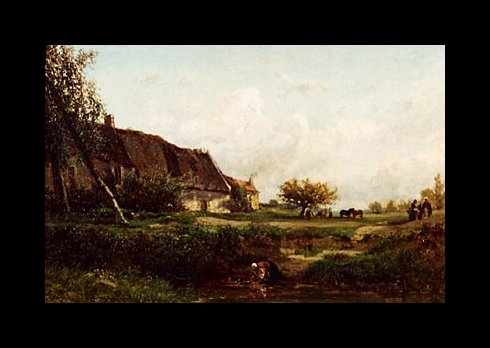Emile Charles Lambinet (1815-1877)
Get a Lambinet Certificate of Authenticity for your painting (COA) for your Lambinet drawing.
For all your Lambinet artworks you need a Certificate of Authenticity (COA) in order to sell, to insure or to donate for a tax deduction.
Getting a Lambinet Certificate of Authenticity (COA) is easy. Just send us photos and dimensions and tell us what you know about the origin or history of your Lambinet painting or drawing.
If you want to sell your Lambinet painting or drawing use our selling services. We offer Lambinet selling help, selling advice, private treaty sales and full brokerage.
We have been authenticating Lambinet and issuing certificates of authenticity since 2002. We are recognized Lambinet experts and Lambinet certified appraisers. We issue COAs and appraisals for all Lambinet artworks.
Our Lambinet paintings and drawings authentications are accepted and respected worldwide.
Each COA is backed by in-depth research and analysis authentication reports.
The Lambinet certificates of authenticity we issue are based on solid, reliable and fully referenced art investigations, authentication research, analytical work and forensic studies.
We are available to examine your Lambinet painting or drawing anywhere in the world.
You will generally receive your certificates of authenticity and authentication report within two weeks. Some complicated cases with difficult to research Lambinet paintings or drawings take longer.
Our clients include Lambinet collectors, investors, tax authorities, insurance adjusters, appraisers, valuers, auctioneers, Federal agencies and many law firms.
We perform Emile Charles Lambinet art authentication, appraisal, certificates of authenticity (COA), analysis, research, scientific tests, full art authentications. We will help you sell your Emile Charles Lambinet or we will sell it for you.
Emile Charles Lambinet is often referred to as one of the members of the Barbizon school. What is strange about this is that he never actually painted in the area surrounding the Forest of Fontainebleau or the village of Barbizon. The reason he is so often associated with this school seems to be because the manner in which he approached rural subjects and landscapes was very much in the same style as the successful Barbizon artists of the day. His style of painting seemed to appeal very much to the same critics and collectors who supported the art of the Barbizon school. As well as painting landscapes he was also well known for his paintings of animals.

He studied under the history painters, Michael Martin Drolling and Emile Jean Horace Vernet. Vernet was of course well known for his paintings celebrating French military prowess, including a series of large battle pieces for Versailles. He also studied under the well known painters of the Barbizon school, Charles Daubigny and Jean Baptist Camille Corot.
He lived most of his life in the area west of Paris near to Versaille. He made regular painting trips to Ecouen, a town north of Paris. He was not the only artist to be enticed by this area. Ecouen was to become an important artist’s colony that would come to include a number of American painters such as Mary Cassatt and Henry Bacon. Mary Cassatt visited Ecouen to study with the artist Paul Soyer.


Charles Emile Lambinet was certainly a successful painter of the nineteenth century. His work was held in high regard by art critics and collectors. It is said that what made his work special was his light and airy brushstrokes which suggest a natural setting as well as his talent for depicting atmospheric conditions such as the wind.
He exhibited in the Salon regularly between 1833, and 1878. He won a number of medals in 1843. In 1867, he was made a Knight of the Legion of Honour.
In the 1850s, and 1860s, collectors in Boston were particularly interested in his work and this helped pave the way for their interest in the Barbizon school. Joseph Foxcroft Cole, an American artist saw a number of paintings by Lambinet in Boston collections and admired them enormously. In 1860 he made his first visit to France to study under Lambinet. Joseph Foxcroft Cole was to bring back to America from his time in France an opalescent variation of the Barbizon style. Cole frequently depicted the rural landscape of Normandy and also Winchester in Massachusetts. A number of other American artists followed Cole, and this lead to Lambinet being very well known in America.
A painting, entitled, ‘Village on the Sea,’ hangs in the Museum of Fine Arts in Boston, and is typical of the work that Lambinet produced. It shows the French country side replete with French peasants, cows and cottages bordering the water.
The relationship that Charles Emile Lambinet had with his American student Joseph Foxcroft Cole was certainly an important one in his artistic career. Cole promoted the work of Lambinet to a number of prominent art collectors of the time, such as Ernest Wadsworth Longfellow. It is partly thanks to Cole that Lambinet found a good market for his work in America and particularly Boston.
Reviews
1,217 global ratings
5 Star
4 Star
3 Star
2 Star
1 Star
Your evaluation is very important to us. Thank you.
